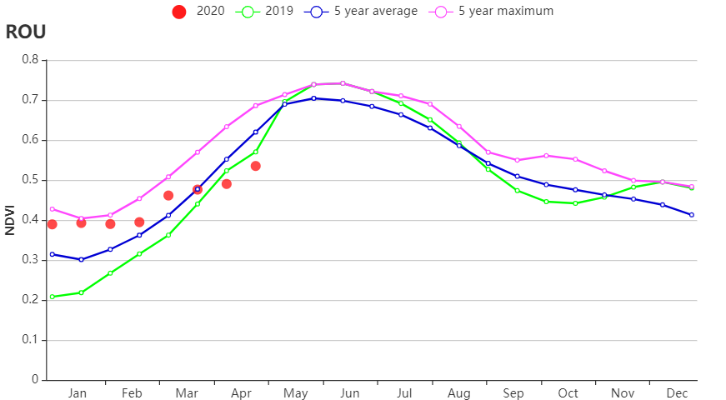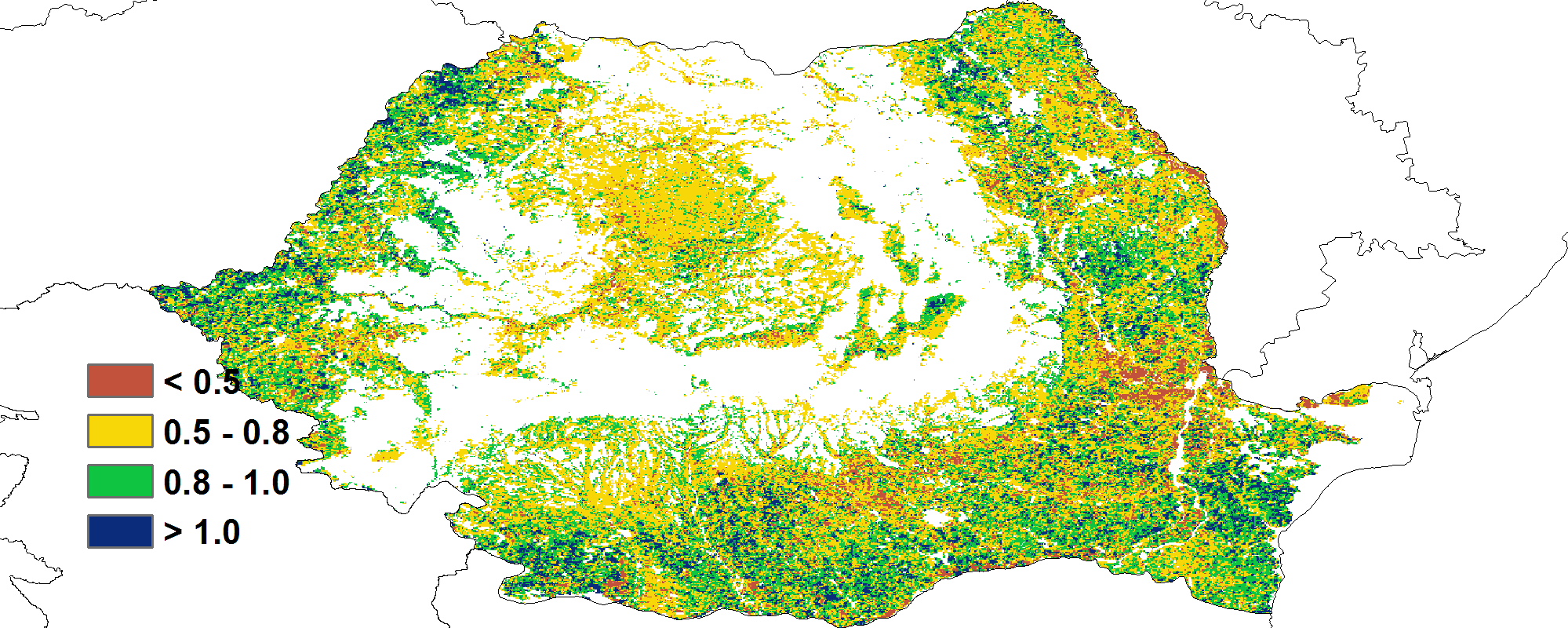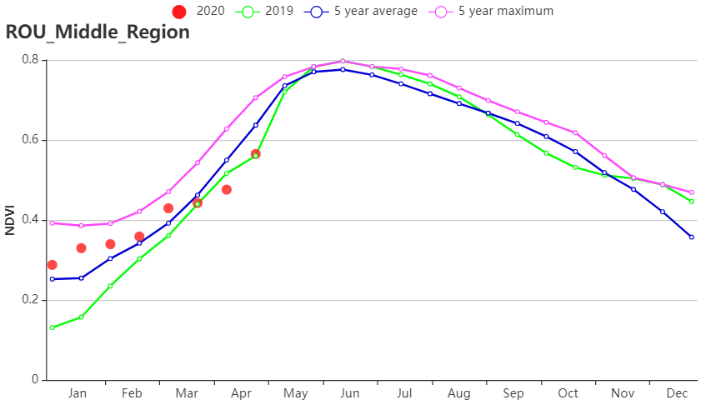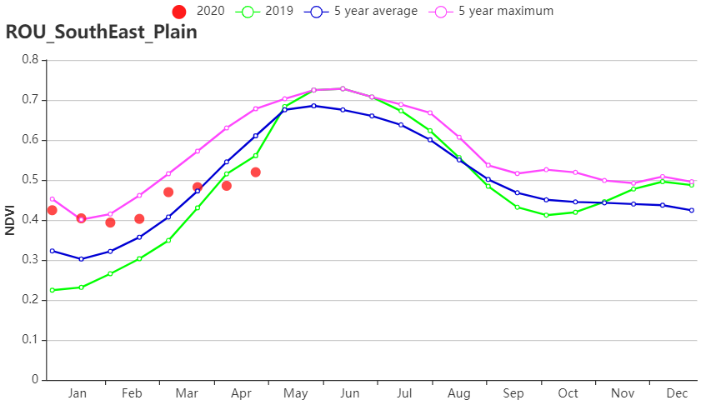
Bulletin
wall bulletinMenu
- Overview
- Country analysis
- Afghanistan
- Angola
- Argentina
- Australia
- Bangladesh
- Belarus
- Brazil
- Canada
- Germany
- Egypt
- Ethiopia
- France
- United Kingdom
- Hungary
- Indonesia
- India
- Iran
- Italy
- Kazakhstan
- Kenya
- Cambodia
- Sri Lanka
- Morocco
- Mexico
- Myanmar
- Mongolia
- Mozambique
- Nigeria
- Pakistan
- Philippines
- Poland
- Romania
- Russia
- Thailand
- Turkey
- Ukraine
- United States
- Uzbekistan
- Viet Nam
- South Africa
- Zambia
- Kyrgyzstan
Authors: 超级管理员 | Edit: yannn
Winter wheat is the main crop that is grown in Romania during this reporting period. It was sown in last October. At the national level, rainfall was 34% below average, down to 179 mm; average temperature was 1.2℃ higher and radiation 11% above average. With fair temperature and radiation conditions, the influence of low rainfall should be noted, as water supply is vital for wheat growth. Due to the low rainfall, biomass decreased by 2%. The CALF of Romania decreased by 8% and current maximum VCI is at 0.77, which is unfavorable for production. According to the NDVI at the country level, crop conditions were above average in March and lower than average in April, which was consistent with the low rainfall in April.
Regional analyses
More details are provided below for three main agro‐ecological zones: the Central mixed farming and pasture Carpathian hills (160), the Eastern and southern maize, wheat and sugar beet plains (161) and the Western and central maize, wheat and sugar beet plateau (162).
For the Central mixed farming and pasture Carpathian hills, compared to the 15YA, rainfall decreased by as much as 28%, while temperature and radiation were both up (TEMP +1.0℃ , RADPAR +12%) and BIOMSS increased by 1%. According to the NDVI development, crop conditions were better than average in January and February but lower than average in March and April. The regional average VCI maximum was at 0.76. The NDVI spatial distribution shows that the NDVI was decreasing in March to April. As the central mixed farming and pasture Carpathian hills occupy only a small fraction of cropland in Romania, this region's low NDVI is not significant for Romania's crop production.
For the Eastern and Southern maize, wheat and sugar beet plains, rainfall decreased by 43%, temperature increased 1.7 ℃, radiation increased 8% and biomass increased 3% as compared to the 15YA. The NDVI development graph shows that crop condition dropped to below average after March. The VCI max value of this region was 0.78 and according to the distribution map, the blue and red line shows that VCI values were decreasing in March in most of the central and middle region, especially in the southeast area of this sub-region (counties of Tulcea and Constanta), representing about 14.3% of the national cropland. They indicate slightly unfavorable crop conditions.
For the Western and central maize, wheat and sugar beet plateau, rainfall was lower than average by 25%, temperature and radiation were somewhat higher (TEMP +0.4℃, RADPAR +9%) and biomass decreased by 11%. Maximum VCI of this region was 0.77 and the spatial distribution was between 0.5 and 0.8 near the middle region. NDVI dropped below the 5YA starting in mid March.
Overall, crop conditions were not optimal in Romania during this reporting period. Winter wheat already suffered from drier-than-normal conditions between October and January. Rainfall in the coming months will be critical for sustained crop growth. Currently, the outlook for the 2020 wheat harvest in Romania is unfavorable.
Figure 3.37 Romania’s crop condition, January – April 2020

(a). Phenology of major crops

(b) Crop condition development graph based on NDVI

(c) Maximum VCI

(d) Spatial NDVI patterns compared to 5YA


(f) Crop condition development graph based on NDVI (Central mixed farming and pasture Carpathian hills (left) and Eastern and southern maize, wheat and sugar beet plains (right))

(g) Crop condition development graph based on NDVI (Western and central maize, wheat and sugar beet plateau)

(h) Time series rainfall profile

(i) Time series temperature profile
Table 3.65 Romania's agroclimatic indicators by sub-national regions, current season's values and departure from 15YA, January – April 2020
RAIN | TEMP | RADPAR | BIOMSS
| |||||
Region | Current (mm) | Departure from 15YA (%) | Current (°C) | Departure from 15YA (°C) | Current (MJ/m2) | Departure from 15YA (%) | Current (gDM/m2) | Departure from 15YA (%) |
Central mixed farming and pasture Carpathian hills | 220 | -28 | 2.4 | 1.0 | 702 | 12 | 130 | 1 |
Eastern and southern maize wheat and sugarbeet plains | 144 | -43 | 5.3 | 1.7 | 722 | 11 | 162 | 3 |
Western and central maize wheat and sugarbeet plateau | 212 | -25 | 3.4 | 0.4 | 690 | 9 | 130 | -11 |
Table 3.66 Romania's agronomic indicators by sub-national regions, current season’s values and departure from 15YA/5YA, January – April 2020
CALF | Maximum VCI | ||
Region | Current (%) | Departure from 5YA (%) | Current |
Central mixed farming and pasture Carpathian hills | 93 | -5 | 0.76 |
Eastern and southern maize wheat and sugarbeet plains | 85 | -9 | 0.78 |
Western and central maize wheat and sugarbeet plateau | 92 | -6 | 0.77 |
